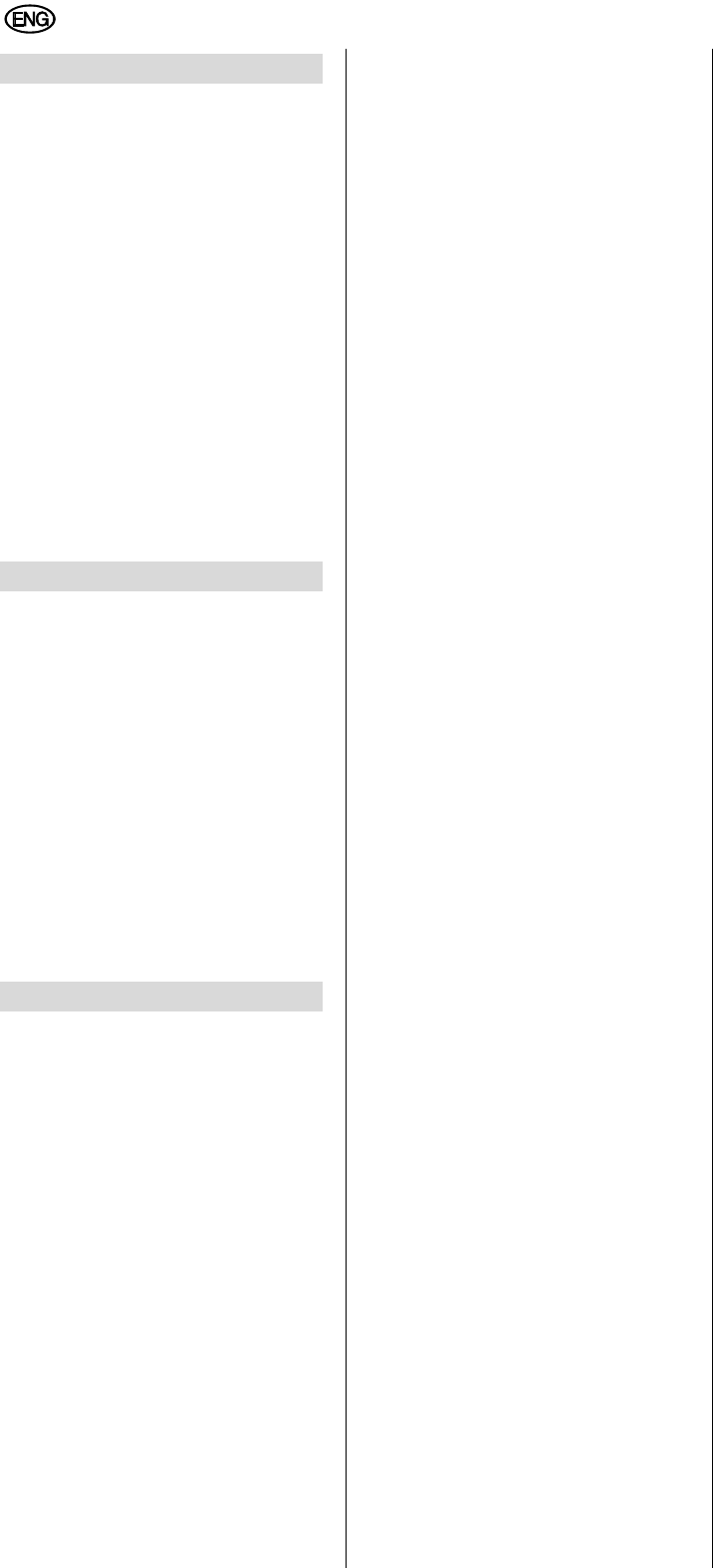
8
ENGLISH
1. Device overview ..........................7
2. Please Read First!.......................8
3. Safety ...........................................8
3.1 Specified conditions of use ...........8
3.2 General safety information............8
3.3 Safety devices...............................9
4. Operation .....................................9
4.1 Mains connection ..........................9
4.2 Generating compressed air...........9
5. Care and Maintenance ................9
5.1 Periodic maintenance....................9
5.2 Device storage ..............................9
6. Trouble Shooting ........................9
7. Repairs .......................................10
8. Environmental Protection ........10
9. Technical Specifications ..........10
• Read these instructions before use.
Pay special attention to the safety
information.
• If you notice transport damage while
unpacking, notify your supplier
immediately. Do not operate the
device!
• Dispose of the packing in an envi-
ronmentally friendly manner. Take
to a proper collecting point.
• Keep these instructions for refer-
ence on any issues you may be
uncertain about.
• If you lend or sell this device be sure
to have the instructions to go with it.
3.1 Specified conditions of use
This device is intended to generate com-
pressed air required for the operation of
air tools.
Any use for medical purposes, food
processing as well as filling of oxygen
cylinders for breathing equipment is not
permitted.
Explosive, combustible gases or gases
detrimental to health may not be com-
pressed. Operation in hazardous loca-
tions is not permitted.
Any other use is not as specified. Use
not as specified, alteration of the device
or use of parts that are not approved by
the equipment manufacturer, can cause
unforeseeable damage!
Children, juveniles and persons not hav-
ing been instructed in its usage are not
permitted to operate this device and any
air tools connected to it.
3.2 General safety information
When using this electric tool observe the
following safety instructions, to exclude
the risk of personal injury or material
damage.
Please also observe the special safety
instructions in the respective chapters;
Keep all documents, supplied with the
device, for future reference.
Observe the statuary accident insurance
institution regulations and regulations for
the prevention of accidents pertaining to
the operation of air compressors and air
tools, where applicable.
A
General hazard!
Keep your work area tidy – a messy
work area invites accidents.
Be alert. Know what you are doing. Set
out to work with reason. Do not operate
electric tool while under the influence of
drugs, alcohol or medication.
Consider environmental conditions.
Keep work area well lighted.
Prevent adverse body positions. Ensure
firm footing and keep your balance at all
times.
Do not operate electric tool near inflam-
mable liquids or gases.
Keep bystanders, particularly children,
out of the work area. Do not permit other
persons to touch the tool or power cable
while the electric tool is running.
Do not overload electric tool – use it only
within the performance range it was
designed for (see Technical specifica-
tions).
B
Danger! Risk of electric shock!
Do not expose electric tool to rain.
Do not operate electric tool in damp or
wet environment.
Prevent body contact with earthed
objects such as radiators, pipes, cooking
stoves or refrigerators when operating
this electric tool.
Do not use the power cable for any pur-
pose it is not intended for.
A
Risk of personal injury by
escaping compressed air and parts
hurled about by escaping air!
Never direct compressed air against per-
sons or animals!
Ensure all air tools and accessories
used are designed for the working pres-
sure or are supplied via a pressure regu-
lator.
Please note that, when disconnecting
the quick coupler, the compressed air
contained in the pressure hose will
escape all of a sudden. You should
therefore firmly hold the air hose when
disconnecting it.
Ensure all screwed connections are fully
tightened at all times.
Do not attempt to repair the device your-
self! Only trained specialists are permit-
ted to service or repair compressors,
pressure vessels and air tools.
A
Hazard generated by oil-satu-
rated compressed air!
Use oil saturated compressed air only
for air tools requiring such supply. Do
not use an air hose used to supply com-
pressed air containing oil to supply air
tools not designed for operation on com-
pressed air containing oil. Do not fill tires
with compressed air containing oil.
A
Risk of burns from the sur-
faces of parts carrying compressed
air!
Let device cool off before servicing.
A
Risk of personal injury and
crushing by moving parts!
Do not operate the device without
installed guards.
Please note that the device will start
automatically when the pressure falls off
to minimum! – Disconnect from power
supply prior to any servicing.
Ensure that when switching on (e.g. after
servicing) no tools or loose parts are in
the electric tool.
A
Hazard generated by insuffi-
cient personal protection gear!
Wear hearing protection.
Wear safety glasses.
Wear mask respirator when work gener-
ates dust or mist detrimental to health.
Wear suitable work clothes When work-
ing outdoors wearing of non-slip shoes is
recommended.
A
Hazard generated by electric
tool defects!
Keep electric tool and accessories in
good repair. Observe the maintenance
instructions.
Prior to any use check the electric tool
for possible damage: before using the
electric tool carefully check safety
devices, protection devices or slightly
damaged parts for proper function as
specified. Check to see that all moving
parts work properly and do not jam. All
parts must be correctly installed and
meet all conditions necessary for the
proper operation of the electric tool.
Damaged protection devices or parts
must be repaired or replaced by an qual-
ified specialist. Have damaged switches
replaced by a service centre. Do not
operate electric tool if the switch can not
be turned ON or OFF.
Keep handles free of oil and grease.
Table of Contents
2. Please Read First!
3. Safety


















